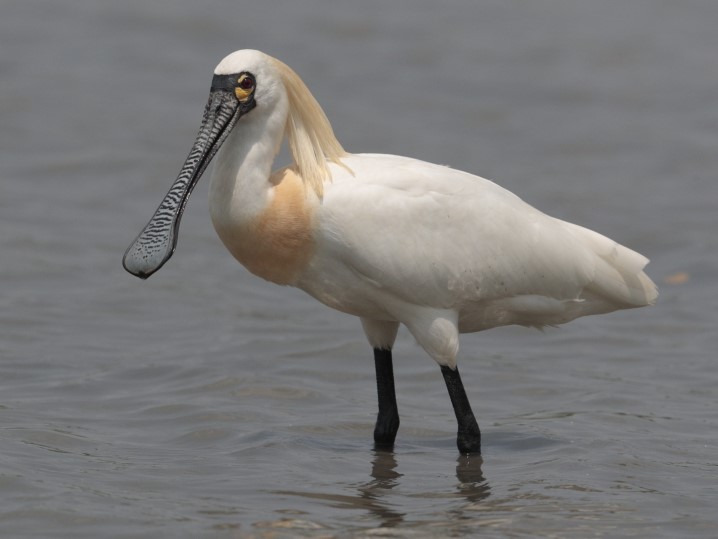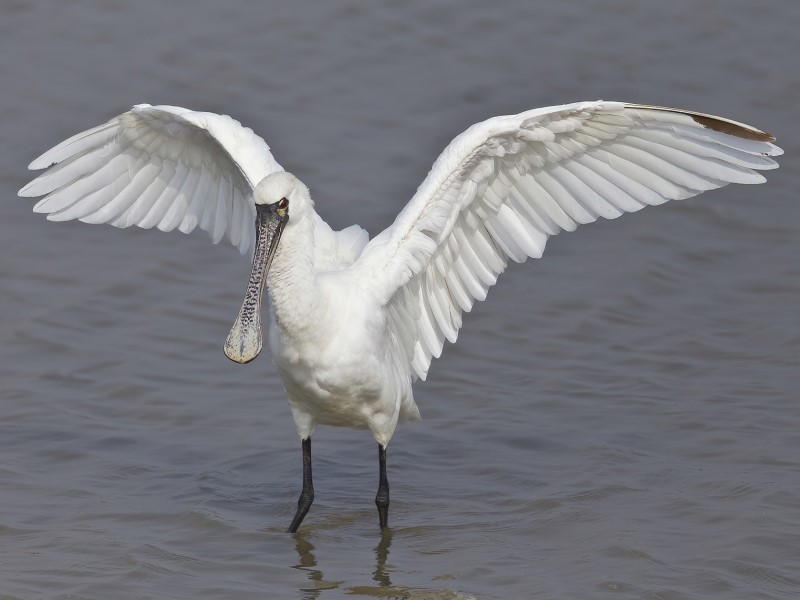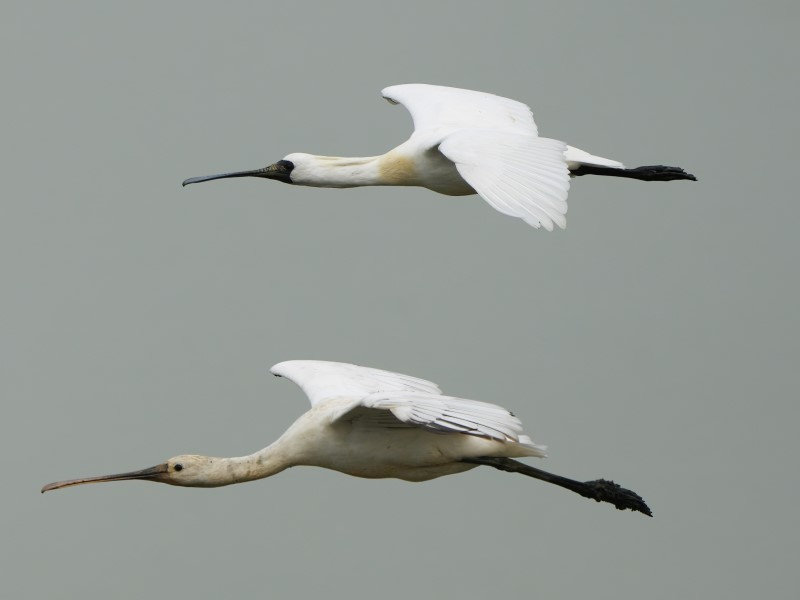Black-faced Spoonbill Platalea minor 黑臉琵鷺
Category I. Common winter visitor to Deep Bay area wetlands, rare in summer. Numbers constituted an average of 16% of the world known population during 2010-14 (Sung et al. 2018) but declined to only 6% in 2022 (Yu et al. 2022).
IDENTIFICATION

May 2021, John and Jemi Holmes. Adult, breeding plumage.
60-79 cm. Large all-white waterbird with long spatulate bill and legs and distinctive foraging action involving sweeping bill side to side in the water. Differs from Eurasian Spoonbill in being slightly smaller and in having black facial skin and bill and whiter plumage. In breeding plumage has broad golden-buff collar and dense buff crest.

Dec. 2012, Martin Hale. Immature.
Adults have white wing tips while young birds have dark wing tips. Young birds take 4 to 5 years to acquire full adult plumage.

Mar. 2024, Paul Leader. Black-faced (upper) and Eurasian (lower) Spoonbills.
Flies with neck extended on shallow wingbeats interspersed with short glides. Compared to Eurasian Spoonbill, may appear smaller in the body and feet, and shorter in the bill, neck and legs.
VOCALISATIONS
Almost silent. Matheu et al. (2020) described “ubuu ubuu” calls during the breeding season. A similar call is heard occasionally when birds fly overhead at close range.
DISTRIBUTION & HABITAT PREFERENCE
Specialised to forage in intertidal areas. Key feeding grounds are shallow water areas (6 to 21 cm depth) with a high density of food, flat bottom and no obstacles. Preferred loafing areas are large and undisturbed with an open view to detect approaching land predators; these could be in or out of water within 2-3 km of tidal areas (Yu and Swennen 2004a).
Almost all records of Black-faced Spoonbill come from the Deep Bay area, with the highest counts generally of loafing birds in the safe refuge provided by managed wetland habitat (e.g., Mai Po Nature Reserve, HK Wetland Park and Lok Ma Chau MTRC Ecological Enhancement Area). Foraging habitats include drained gei wai, fishponds, intertidal mudflat and drained channels of Kam Tin River, Shan Pui River and at Tin Shui Wai during low tide period.
Away from the Deep Bay area, individuals or small flocks usually in flight have been rarely recorded at Cheung Chau, Starling Inlet (including one at Luk Keng marsh), Tai Lam Chung Reservoir and Tai Po.
OCCURRENCE
The earliest Black-faced Spoonbills usually arrive mid-October, after when numbers rise quickly in November and remain high in both November and December. After a drop in January, numbers are higher again in February and March (Figure 1). Anon. (1999) suggested there is no obvious passage through HK, and that the fluctuation in numbers recorded is mainly related to the tidal regime, local movements and the availability of other resting places. While lower numbers in January could be due to low diurnal high tides allowing individuals to remain in the mudflat area, this should equally be the case in December, if not more so.
Number fall significantly in April as adults leave for the breeding grounds. A number of birds in HK and Taiwan were fitted with satellite transmitters during the winters of 1997-98 and 1998-99 (see Melville, Leader and Carey 1999, Ueta et al. 2002), and northward migration was successfully tracked in spring 1999. The results indicated that adult males wintering in HK begin northward migration around the third week of March, adult females leave around early April and immatures leave in the second half of April and early May. Summer records generally refer to first-summer birds.
The first HK record occurred in 1956 (Walker 1958), though it had probably been recorded prior to then. Numbers remained no higher than 35 until the late 1980s (Kennerley 1990), a reflection of the small global population. Numbers started to increase in the 1990s and reached a peak during 2009-2011; since then, there has been some fluctuation (Figure 2). Sung et al. (2021) found that the wintering population increased from 1998 to 2017. The highest count in HK is 496 on 24 January 2010.
BEHAVIOUR, FORAGING & DIET
Spoonbills are generally present at loafing sites throughout the daytime, but numbers vary as fewer remain during the low tide period, at dawn and at dusk when they prefer to feed. However, they are sufficiently opportunistic to feed anytime in drained fishponds and gei wai if prey is available. Large loafing flocks can also be recorded at night (Yu and Swennen 2004b).
They feed entirely on animals caught in the water column, of which fish and shrimp are the main prey items with occasional observations of crabs up to 5 cm. (Swennen and Yu 2004, 2005). A recent DNA metabarcoding study also brought a similar result as main prey items were fish, shrimps and crabs (Huang et al. 2021).
Black-faced Spoonbills prefer to gather in flocks that are both interspecific and intraspecific with ardeids and closely-related Eurasian Spoonbills. They are highly social and interact with other individuals for preening their head feathers and companions for safety.
RANGE & SYSTEMATICS
Monotypic. Breeds almost entirely in the Yellow Sea on islands off the west coast of the Korean Peninsula and Liaoning province, China; there is also a small breeding population on Furugelma Island, Peter the Great Bay, Russia Far East (BirdLife International 2017). Winters coastally from the southern part of the Korean Peninsula south through Jeju island, western Japan, east and south China, including Taiwan and Hainan, north Vietnam and north Philippines. Young birds wander further south to Thailand, the Malay Peninsula and north Borneo (BirdLife International 2017, Yu et al. 2022) and occasionally inland areas (Chen et al. 2021, Yu and Swennen 2005).
CONSERVATION STATUS
IUCN: ENDANGERED. Population expected to decline very rapidly over next three generations.
Mai Po and Deep Bay have long been an important wintering ground for this species. Conservation management of the Mai Po Nature Reserve was a major contributory factor in pulling the species from the brink of extinction. A recent study assessing conservation activities and long-term survival of Black-faced Spoonbill showed that it is likely to fully recover if conservation actions are continued and well-coordinated (Cano-Alonso et al. 2023).
Figure 1.

Figure 2.

Anon. 1999. Conservation management of critically endangered Black-faced Spoonbills Platalea minor in the Mai and Inner Deep Bay Ramsar site. Unpub. report by WWF to Agriculture, Fisheries and Conservation Department, HKSAR Government, WWF Hong Kong.
BirdLife International (2017). Platalea minor. The IUCN Red List of Threatened Species 2017: e.T22697568A119347801. https://dx.doi.org/10.2305/IUCN.UK.2017-3.RLTS.T22697568A119347801.en. Accessed on 23 February 2023.
Cano-Alonso, L. S., M. K. Grace, Y. T. Yu and S. Chan (2023). Reversing the decline in a threatened species: The Black-faced Spoonbill Platalea minor. Diversity 15, 217. https:// doi.org/10.3390/d15020217
Chen, Y. Y. T. Yu, F. Meng, X. Deng, L. Cao and A. D. Fox, (2021). Migration routes, population status and important sites used by the globally threatened Black-faced Spoonbill (Platalea minor): A synthesis of surveys and tracking studies. Avian Research 12, 74. https://doi.org/10.1186/s40657-021-00307-z
Huang, P.Y, E.S.K. Poon, A.T.C. Wong, I.W.Y. So, Y.H., Sung and S.Y.W. Sin (2021). DNA metabarcoding reveals the dietary composition in the endangered black-faced spoonbill. Scientific Reports 11, 18773. https://doi.org/10.1038/s41598-021-97337-w
Kennerley, P. R. (1990). A review of the status and distribution of the Black-faced Spoonbill. Hong Kong Bird Report 1989: 116-125.
Matheu, E., J. del Hoyo, and G. M. Kirwan (2020). Black-faced Spoonbill (Platalea minor), version 1.0. In Birds of the World (J. del Hoyo, A. Elliott, J. Sargatal, D. A. Christie, and E. de Juana, Editors). Cornell Lab of Ornithology, Ithaca, NY, USA. https://doi.org/10.2173/bow.blfspo1.01
Melville, D. S., P. J. Leader and G. J. Carey (1999). ‘Movements and biometrics of Black-faced Spoonbills Platalea minor at Mai Po, Hong Kong in spring 1998’. In Ueta, M., R. Kurosawa and D. Allen (eds), Conservation and Research of Black-faced Spoonbills and their habitats pp. 19-26. Wild Bird Society of Japan, Tokyo.
Sung, Y. H., I. W. L. Tse and Y. T. Yu (2018). Population trend of the Black-faced Spoonbill Platalea minor: analysis of data from international synchronised censuses. Bird Conservation International 28: 157-167.
Sung, Y. H., Pang, C. C., Li, T. C. H., Wong, P. P. Y., & Yu, Y. T (2021). Ecological correlates of 20-year population trends of wintering waterbirds in Deep Bay, South China. Frontiers in Ecology and Evolution, 9, 247. https://doi.org/10.3389/fevo.2021.658084
Swennen, C. and Y. T. Yu (2004). Notes on feeding structures of the Black-faced Spoonbill Platalea minor. Ornithological Science 3: 119-124.
Swennen, C. and Y. T. Yu (2005). Food and feeding behaviour of the black-faced spoonbill. Waterbirds 28: 19-27.
Ueta, M., D. S. Melville, Y. Wang, K. Ozaki, Y. Kanai, P. J. Leader, C. C. Wang and C.Y. Kuo (2002). Discovery of the breeding sites and migration routes of Black-faced Spoonbill Platalea minor. Ibis 144: 340-343. https://doi.org/10.1046/j.1474-919X.2002.00037
Walker, F. J. (1958). Field observations on birds in the Colony of Hong Kong. Hong Kong Bird Watching Society, Hong Kong (duplicated).
Yu, Y. T. and C. Swennen (2004a). Habitat use of the Black-faced Spoonbill. Waterbirds 27: 129-134.
Yu, Y. T. and C. Swennen (2004b). Feeding of wintering Black-faced Spoonbills in Hong Kong: When and how long? Waterbirds 27: 135-140.
Yu, Y. T. and C. Swennen (2005). Black-faced Spoonbill wintering in inland China. BirdingASIA 4:63.
Yu, Y. T., K. Y. Yip, C. H. Li, P. Y. Kong, C. T. Chung and A. L. Moulin (2022). International Black-faced Spoonbill Census 2022 Report. Black-faced Spoonbill Research Group. The Hong Kong Bird Watching Society. Download at: https://cms.hkbws.org.hk/cms/component/phocadownload/file/837-bfs-census-report-2022-trad

